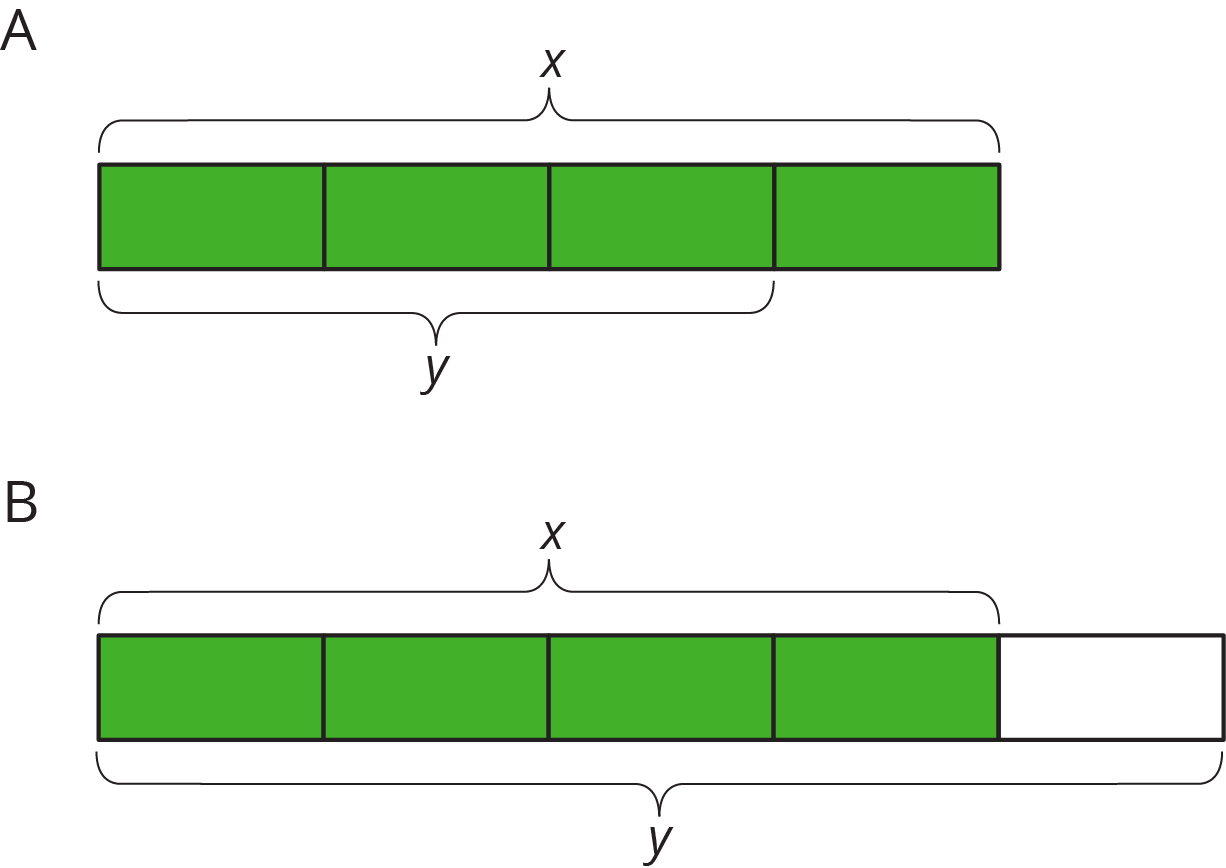Lesson 5
Say It with Decimals
Let’s use decimals to describe increases and decreases.
5.1: Notice and Wonder: Fractions to Decimals
A calculator gives the following decimal representations for some unit fractions:
\(\frac12 = 0.5\)
\(\frac13 =0.3333333\)
\(\frac14 = 0.25\)
\(\frac15 = 0.2\)
\(\frac16 = 0.1666667\)
\(\frac17 = 0.142857143\)
\(\frac18 = 0.125\)
\(\frac19 = 0.1111111\)
\(\frac{1}{10} = 0.1 \)
\( \frac{1}{11}=0.0909091\)
What do you notice? What do you wonder?
5.2: Repeating Decimals
-
Use long division to express each fraction as a decimal.
\(\frac{9}{25}\)
\(\frac{11}{30}\)
\(\frac{4}{11}\)
- What is similar about your answers to the previous question? What is different?
- Use the decimal representations to decide which of these fractions has the greatest value. Explain your reasoning.
One common approximation for \(\pi\) is \(\frac{22}{7}\). Express this fraction as a decimal. How does this approximation compare to 3.14?
5.3: More and Less with Decimals
-
Match each diagram with a description and an equation.
Diagrams:

Descriptions:
An increase by \(\frac14\)
An increase by \(\frac13\)
An increase by \(\frac23\)
A decrease by \(\frac15\)
A decrease by \(\frac14\)
Equations:
\(y=1.\overline{6}x\)
\(y=1.\overline{3}x\)
\(y=0.75x\)
\(y=0.4x\)
\(y=1.25x\)
- Draw a diagram for one of the unmatched equations.
5.4: Card Sort: More Representations
Your teacher will give you a set of cards that have proportional relationships represented 2 different ways: as descriptions and equations. Mix up the cards and place them all face-up.
Take turns with a partner to match a description with an equation.
- For each match you find, explain to your partner how you know it’s a match.
- For each match your partner finds, listen carefully to their explanation, and if you disagree, explain your thinking.
- When you have agreed on all of the matches, check your answers with the answer key. If there are any errors, discuss why and revise your matches.
Summary
Long division gives us a way of finding decimal representations for fractions.
For example, to find a decimal representation for \(\frac{9}{8}\), we can divide 9 by 8.
\(\require{enclose} \begin{array}{r} 1.125 \\[-3pt] 8 \enclose{longdiv}{9.000}\kern-.2ex \\[-3pt] \underline{8{\phantom{.0}}} \phantom{00} \\[-3pt] 1\phantom{.}0\phantom{00} \\[-3pt] \underline{8\phantom{0}}\phantom{0} \\[-3pt] 20\phantom{0} \\[-3pt] \underline{16\phantom{0}} \\[-3pt] \phantom{0} 40 \\[-3pt] \underline{40} \\[-3pt] 0 \\ \end{array}\)
So \(\frac{9}{8} = 1.125\).
Sometimes it is easier to work with the decimal representation of a number, and sometimes it is easier to work with its fraction representation. It is important to be able to work with both. For example, consider the following pair of problems:
- Priya earned \(x\) dollars doing chores, and Kiran earned \(\frac{6}{5}\) as much as Priya. How much did Kiran earn?
- Priya earned \(x\) dollars doing chores, and Kiran earned 1.2 times as much as Priya. How much did Kiran earn?
Since \(\frac{6}{5}=1.2\), these are both exactly the same problem, and the answer is \(\frac{6}{5}x\) or \(1.2x\). When we work with percentages in later lessons, the decimal representation will come in especially handy.
Video Summary
Glossary Entries
- long division
Long division is a way to show the steps for dividing numbers in decimal form. It finds the quotient one digit at a time, from left to right.
For example, here is the long division for \(57 \div 4\).
\(\displaystyle \require{enclose} \begin{array}{r} 14.25 \\[-3pt] 4 \enclose{longdiv}{57.00}\kern-.2ex \\[-3pt] \underline{-4\phantom {0}}\phantom{.00} \\[-3pt] 17\phantom {.00} \\[-3pt]\underline{-16}\phantom {.00}\\[-3pt]{10\phantom{.0}} \\[-3pt]\underline{-8}\phantom{.0}\\ \phantom{0}20 \\[-3pt] \underline{-20} \\[-3pt] \phantom{00}0 \end{array} \)
- percentage
A percentage is a rate per 100.
For example, a fish tank can hold 36 liters. Right now there is 27 liters of water in the tank. The percentage of the tank that is full is 75%.
- repeating decimal
A repeating decimal has digits that keep going in the same pattern over and over. The repeating digits are marked with a line above them.
For example, the decimal representation for \(\frac13\) is \(0.\overline{3}\), which means 0.3333333 . . . The decimal representation for \(\frac{25}{22}\) is \(1.1\overline{36}\) which means 1.136363636 . . .
- tape diagram
A tape diagram is a group of rectangles put together to represent a relationship between quantities.
For example, this tape diagram shows a ratio of 30 gallons of yellow paint to 50 gallons of blue paint.

If each rectangle were labeled 5, instead of 10, then the same picture could represent the equivalent ratio of 15 gallons of yellow paint to 25 gallons of blue paint.
- unit rate
A unit rate is a rate per 1.
For example, 12 people share 2 pies equally. One unit rate is 6 people per pie, because \(12 \div 2 = 6\). The other unit rate is \(\frac16\) of a pie per person, because \(2 \div 12 = \frac16\).
